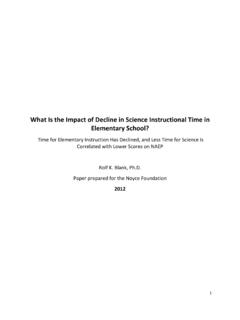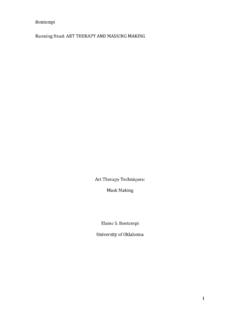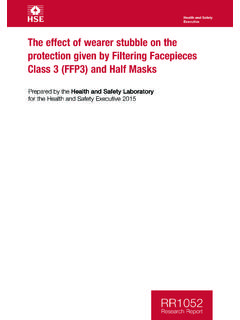Transcription of DESIGNING A PRESERVICE ELEMENTARY METHODS COURSE …
1 1 THE NATURE OF SCIENCE AND SCIENTIFIC KNOWLEDGE: IMPLICATIONS FOR DESIGNING A PRESERVICE ELEMENTARY METHODS COURSE YVONNE J. MEICHTRY School of Education, Northern Kentucky University, Nunn Drive, Highland Heights, KY, 41099 ABSTRACT: This article describes teaching considerations related to the nature of science and scientific knowledge in an ELEMENTARY science METHODS COURSE . The decisions that were made, the rationale upon which these decisions were based, and the challenges evident are presented. Instructional strategies used during the COURSE for the purpose of developing PRESERVICE teachers understandings of the nature of science and scientific knowledge are described. The results of using these strategies, in regard to the impact on students learning and their views on teaching the nature of science to ELEMENTARY grade students are then discussed. The article concludes with a discussion on the implications for teaching the nature of science and scientific knowledge in the context of PRESERVICE ELEMENTARY teacher education.
2 INTRODUCTION This article presents a summary of challenges that are evident and decisions that have been made regarding efforts to both teach and research the teaching of the nature of science and scientific knowledge. The sources of information upon which the views expressed are based include the practical experiences of teaching the nature of science and scientific knowledge to middle school students and PRESERVICE ELEMENTARY education teachers, an examination of literature over 30 years, the results of research studies conducted at various levels of education, data collected during the evaluation of efforts to reform science education, and current national standards for 2teaching the nature of science. The context for which the information presented has implications is the preparation of PRESERVICE ELEMENTARY science teachers. The experiences of this author when DESIGNING and teaching an ELEMENTARY science METHODS COURSE has led to the following questions regarding the nature of science and scientific knowledge: 1) What aspects need to be included to fully represent the multi-faceted nature of science?
3 ; 2) What are the most effective ways of developing these understandings?; and 3) What is a realistic expectation, in the context of this COURSE , in regard to developing these understandings? The challenges evident in answering these questions include a literature base that defines the nature of science and scientific knowledge in a variety of ways and through the use of inconsistent terminology, a research base that is largely incomplete, and a general lack of attention to the nature of science and scientific knowledge by science education curricula at the K-12 and university levels. A careful examination of literature-based information which does exist, coupled with the knowledge base relating to constructivist teaching premises, however, has resulted in successful efforts to incorporate learnings about the nature of science and scientific knowledge in an ELEMENTARY science METHODS COURSE . CONSIDERATIONS RELATED TO TEACHING THE NATURE OF SCIENCE AND SCIENTIFIC KNOWLEDGE Meanings Associated With the Nature of Science and the Nature of Scientific Knowledge 3 The nature of science and nature of scientific knowledge are two dimensions of scientific literacy sometimes used interchangeably in the literature to refer to the same understandings.
4 There are, however, distinctions between these two dimensions of scientific literacy which merit discussion. The differences generally relate to the distinctions which can be made between the terms "science" and "scientific knowledge". The definition of science presented below, used as a working definition of science in the author s COURSE , helps to depict the distinctions made between the nature of science and the nature of scientific knowledge. Aspects of this definition which depict the nature of science attest to science as a human activity, a process used to investigate natural phenomena, a process used to add to an existing knowledge base, and a social enterprise. Scientific knowledge, as presented in the definition, is a product of the human process of science and its social context. A Working Definition of Science: Science is a human activity through which problems and questions dealing with natural phenomena can be identified and defined, and solutions proposed and tested.
5 In this process, data are collected and analyzed, and available knowledge is applied to explaining the results. Through this activity, investigators add to the store of knowledge, thereby helping people better understand their surroundings. Applications of this knowledge also may bring about changes in society and the cultural order and may have a direct bearing on the quality of life (Wisconsin Department of Public Instruction, 1986). Definitions of the nature of scientific knowledge presented in the literature are diverse and multi-faceted. Showalter (1974) used the terms tentative, public, replicable, probabilistic, 4humanistic, historic, unique, holistic, and empirical to characterize the nature of scientific knowledge. After conducting a review of literature on the nature of scientific knowledge, Rubba and Anderson (1978) consolidated the nine factors identified by Showalter into a six-factor model called A Model of the Nature of Scientific Knowledge.
6 The six factors included by Rubba and Anderson are defined as amoral (scientific knowledge itself cannot be judged as morally good or bad), creative (scientific knowledge is partially a product of human creativity), developmental (scientific knowledge is tentative), parsimonious (scientific knowledge attempts to achieve simplicity of explanation as opposed to complexity), testable (scientific knowledge is capable of empirical test), and unified (the specialized sciences contribute to an interrelated network of laws, theories, and concepts). Cotham and Smith (1981) use the terms "tentative" and "revisionary" to define the nature of scientific theories. The tentative component of this conception emphasizes the inconclusiveness of all knowledge claims in science. The revisionary component emphasizes the revision of existing scientific knowledge in response to changing theoretical contexts. While the nature of science has been used as terminology in the literature to represent the same facets as scientific knowledge, it is usually presented in a broader context.
7 This broader context includes not only the nature of scientific knowledge, but the nature of the scientific enterprise and the nature of scientists as well (Cooley & Klopfer, 1963; Kimball, 1968). A theoretical model of the nature of science was developed by Kimball (1968) out of extensive study of the literature on the nature and philosophy of science. The declarations forming this 5model are: (1) curiosity is the fundamental driving force in science; (2) science is a dynamic, ongoing activity; (3) science aims at comprehensiveness and simplification; (4) there are many METHODS of science; (5) the METHODS of science are characterized by attributes which are more in the realm of values than techniques; (6) a basic characteristic of science is a faith in the susceptibility of they physical universe to human ordering and understanding; (7) science has a unique attribute of openness; and (8) tentativeness and uncertainty mark all of science.
8 This model is consistent in its agreement with views expressed by Conant (1961) and Bronowski (1953), and additional support for each assertion is found among the writings of other philosophers of science. According to Klopfer (1969), the processes of scientific inquiry and the developmental nature of knowledge acquisition in science depict the nature of science. He identifies the understanding of how scientific ideas are developed as one of three important components of scientific literacy. According to Klopfer, every student must learn how scientific ideas are formulated, tested, and inevitably, revised, and he/she must learn what impels scientists to engage in this activity. According to the objectives formulated by the National Assessment of Educational Progress (NAEP), the major purpose of science education is to develop scientifically literate individuals. The NAEP objectives for 1985-86, taking into account recent developments and new emphases, provide a definition of scientific literacy that includes both the body of knowledge in the traditional disciplines and knowledge about the nature and history of science.
9 The Nature of Science category is designed to measure students' understanding of the characteristics and METHODS of scientific inquiry and their ability to apply the processes of science to the solution of 6problems. The History of Science is a new area of the assessment designed to measure students' knowledge and understanding about how scientific ideas and theories develop and change over time, how society has influenced scientific development, and how developments in science have affected society. In a process that took three years, the National Council on Science and Technology Education, drawing on the expertise of scientists, engineers, mathematicians, historians, and educators, prepared a set of recommendations on what understandings and habits of mind are essential for all citizens in a scientifically literate society. These recommendations are presented in Project 2061: Science For All Americans, a report prepared by the American Association for the Advancement of Science (1989).
10 An understanding of the nature of science is one of four categories of knowledge, skills, and attitudes identified by the national council as essential for all citizens in a scientifically literate society. Three principle components of the nature of science, as defined by the national council are (pp. 25-31): 1. Scientific world view - the world is understandable, scientific ideas are subject to change, scientific knowledge is durable, and science cannot provide complete answers to all questions; 2. Scientific METHODS of inquiry - science demands evidence, science is a blend of logic and imagination, science explains and predicts, scientists try to identify and avoid bias, and science is not authoritarian; and 3. Nature of the scientific enterprise - science is a complex social activity, science is organized into content disciplines and is conducted in various institutions, there are 7generally accepted ethical principles in the conduct of science, and scientists participate in public affairs both as specialists and as citizens.







